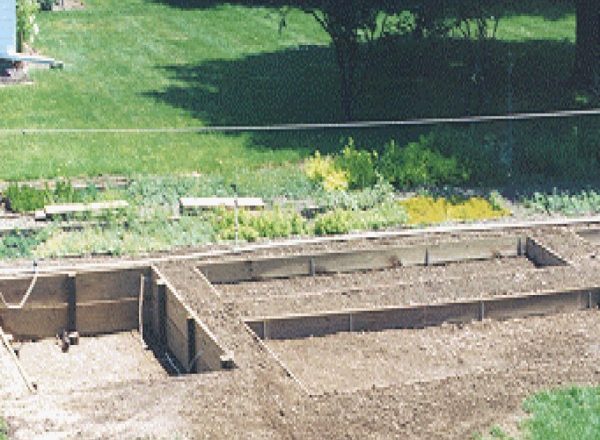Throughout this web site, and in my book Free Landscape Plants!, I teach you many ways to grow your own landscape plants without a greenhouse. And it’s true, you don’t need a greenhouse, but maybe you just want one! A greenhouse is great for your mental health, especially if you live in the north.
When I built my greenhouse I did something a little different from the norm. At our house we are blessed with a sandy gravel type of soil that drains well. Because of this soil type we never have a problem with standing water anywhere in our yard. Therefore, I was able to dig a hole 2′ deep for the foundation of my greenhouse. In the left side of the above photo you can see the foundation in place, before any of the other construction has begun. The frames to the right are cold frames where I grow my landscape plants in 2 quart containers.

Although not necessary, there are several benefits of lowering the floor of your greenhouse as I have done. One, by dropping the floor 2′, I was able to make my trusses 2′ closer to the ground, making my greenhouse a little less conspicuous in the yard. Two, you won’t believe how much more efficient it is to heat a greenhouse where the floor is 2′ lower than ground level. There is heat from the earth that is generated naturally, just 24″ makes a world of difference.
Of course the down side is, you’ve got to dig the hole, and find a place for the soil. I made the best of this situation by first renting a small tractor with a front end loader and a backhoe for a day, at a cost of about $200.. While I had the tractor I got my money’s worth by not only digging the hole for the greenhouse, but by also digging four more cold frames for my container plants. I also used the tractor to remove the topsoil from the area where I was going to build our brick patio.
All of the soil that I excavated I piled in two piles behind the location of our proposed new patio. One pile eventually became a beautifully landscaped mound just off the edge of the patio, and the other pile became the background for our waterfall, and it too is beautifully landscaped. There is a page at this site that features the waterfall and the patio. Just select it from the table of contents.
If you choose not to lower your greenhouse as I did, the construction is quite simple. More about that in a minute, but first let’s consider what you can do in a greenhouse. I use mine for grafting Laceleaf Weeping Japanese Maples. Next year I will likely set up a hot water, bottom heat system in mine so I can quickly root evergreen cuttings in early winter, and then change over to grafting later in the winter. You can also grow your own flowers and vegetables. My mom has a greenhouse full of Cactus plants.
A backyard greenhouse doesn’t have to be fancy to be effective. As long as it is functional, it will serve you well.
In the above photo you can see my greenhouse constructed over top of the foundation you saw in the earlier photo. The structure of this greenhouse is nothing more than some homemade trusses made of pressure treated 2 by 4’s. I designed the trusses by drawing the shape I wanted on our garage floor with chalk. This is very similar to the popular backyard storage sheds sold at most lumber yards.
I made the trusses 7′ overall from the peak to the bottom, knowing that I was going to dig a posthole, and set the legs of the trusses 2′ in the ground. Since my floor is 2′ lower than ground level, this makes the highest part of the ceiling 7′, which gives me plenty of room to work. If you are going to construct your greenhouse at ground level, I would make the overall height of the truss 9′ to allow 2′ to be buried in the ground and still give you a 7′ ceiling.
The inside dimensions of the foundation of my greenhouse are 8′ by 12′. So I made the trusses wider than 8′ to allow the greenhouse to sit completely over top of the pit. The trusses are in no way attached to the foundation. The stability comes from each leg of the trusses being buried in the ground 2′. The trusses are also tied together at ground level with 2″ by 6″ pressure treated boards.
The trusses are tied together at the top with 1″ by 4″ boards that are mitered so they fit together tighter to make a ridge. I enclosed the ends with pressure treated plywood and constructed a full door on one end, and a half door on the other. The half door is to allow for a cross breeze when it is warm enough to open the doors for ventilation.
My greenhouse is fully improved with all the necessary utilities for comfort. I built this structure close to our house so I could easily run water, gas, and electric lines. In the above photo you can see the gas heater covered with a blue tarp, and the stack pipe on the outside of the back wall.
I cover the greenhouse with 6 mil greenhouse plastic. Construction plastic does not work well because it does not contain the inhibitors to block the ultraviolet rays of the sun, thus the plastic will not last. When you buy greenhouse plastic they rate it as 1 year or 3 year depending on how long you want it to last. Currently I am using 1 year plastic, mainly because there is a lot of activity around my greenhouse during the summer. Sure enough if I left the plastic on year round, a football, a baseball, a rock thrown from the weed wacker or some other flying object would take it out.
Before pulling the plastic over the trusses I covered the points where the plastic is going to rest on the wood with duct tape because the wood is abrasive. I saved all the scraps from the rubber pond liner I used on the waterfall, and will likely use that from now on instead of the duct tape.
I secure the plastic on the ends and along the bottom side boards with 1″ by 2″ furring strips and wood screws. I do not attach the plastic to the ridge boards or the trusses because I’ve got a secret to tell you.

Nurseryman (and nurseryladies!) use a rather unique, but extremely effective way of insulating their plastic greenhouses to make them more efficient. They cover them with two layers of plastic, and then blow air between the layers to create a dead air zone, which is the secret to insulating any structure.
If you look closely at the above photo, you can see where the blower I use is installed. Look on the right hand side of the photo, all the way to the end of the greenhouse where there is one board running horizontal between the last two trusses. See the electric wires? My blower is mounted on that board. It is covered with plastic to keep it out of the weather while there is no plastic on the house. Pretty cool huh?
source : Mike McGroarty



